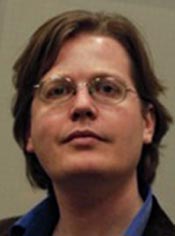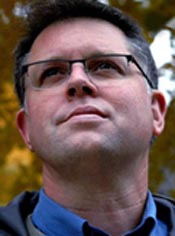Campus News
Crossing the boundaries of media-focused computer science, digital humanities and arts
Interaction between media-focused computer science, the digital humanities and digital arts have the potential to drive major progress in interactive media creation and understanding.

Johnston 35th Reunion at the University of Redlands Febuary 14th and 15th 2004. "JC Fables Past, Present, Future… and a Little Opera Too" main dinner event, Orton Center.

All interactive media—whether in art, entertainment, education, or research—are driven by computational processes.
But it has become apparent that as interactive media have been rapidly growing in importance to the field of computer science, other disciplines in the arts and humanities are also developing new approaches to computational processes.
In fact, interaction between media-focused computer science, the digital humanities and digital arts might have the potential to drive major progress in interactive media creation and understanding.
With that in mind, UCSC’s Center for Games and Playable Media, in collaboration with the campus’s Institute for Humanities Research, will host a three-day workshop, August 26-29, to discuss these issues.
The meeting is supported by an unprecedented group of partners, including the National Science Foundation, National Endowment for the Humanities, National Endowment for the Arts, and both Microsoft Research and Microsoft Studios.
Participants will include academic leaders from across the country who have been crossing the boundaries of media-focused computer science, the digital humanities and the digital arts.
Industry leaders from feature film, video games, and virtual worlds will also be in attendance.
“This is the first project, to my knowledge, that has involved the NSF, NEH, and NEA all together,” noted Noah G. Wardrip-Fruin, UCSC associate professor of computer science. “And I think it’s a sign of things to come.”
“Computer science, the digital humanities, and the digital arts are making important new connections–particularly around our changing view of computational processes as cultural objects, tools, and expressions–which this project aims to bring to a new level of awareness and help catalyze in taking the next step. It’s an important thing in universities, but also in industry,” he added.
These efforts offer the potential to create endless possibilities for media ranging from digital art to computer games, interactive narratives, and transmedia entertainment.
They also offer the opportunity to enable those with an artistic vision to create types of media more computationally complex than is now currently possible for those not trained in computer science.
The goal of the gathering is to create a whitepaper summarizing lessons learned and future directions to take, as well as a set of multi-institution project proposals designed to move the field forward.
In addition, talks from the meeting will be made available on video, and the findings will be presented at other national meetings across the country.
For more information and a list of event participants, visit the event web site.
Note: This workshop is not open to the public, but videos of the sessions will be made available. Contact Noah G. Wardrip-Fruin at: nwf@soe.ucsc.edu.